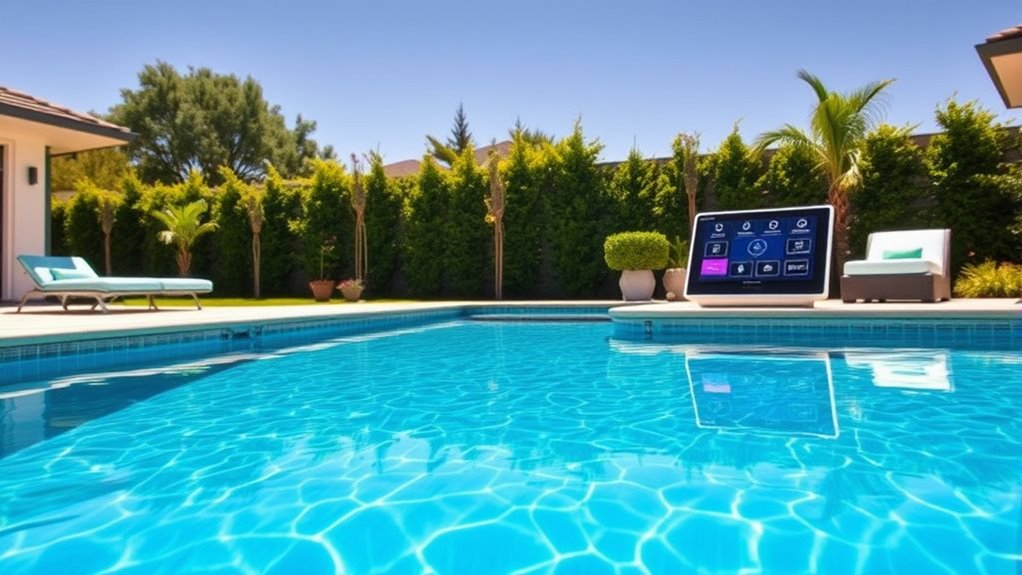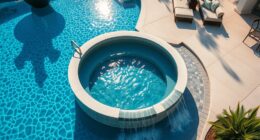Smart pool systems make pool ownership easy by automating water chemistry, cleaning, and climate control. You can control and monitor your pool remotely via apps, adjusting temperature, pump speeds, and lighting easily. Sensors keep water balanced and debris-free, while robotic cleaners scrub surfaces automatically. These systems also improve energy efficiency with scheduled operation. If you want to discover how these features work together seamlessly, you’ll find plenty of tips and insights ahead.
Key Takeaways
- Automate pool cleaning, water chemistry, and temperature control for effortless maintenance and optimal swimming conditions.
- Use sensors and remote apps to monitor and adjust water quality, chemical levels, and system performance in real-time.
- Program schedules for filtration, lighting, and cleaning, reducing energy use and manual intervention.
- Integrate with home automation for seamless control of pool and environmental features via voice or smartphone.
- Receive alerts and diagnostics to prevent issues, ensuring a safe, clean, and inviting pool environment with minimal effort.
Understanding Smart Pool System Components

A smart pool system relies on several key components working together to keep your pool clean and balanced. The main control panel acts as the brain, coordinating all functions and connecting with your Wi-Fi. Sensors are essential; they monitor water temperature, pH levels, and chlorine, providing real-time data. Pumps and filters circulate water continually, ensuring debris removal and proper filtration. Some systems include robotic cleaners that automatically scrub the pool surfaces. Additionally, valve actuators control water flow, directing it where needed. Integration of these components allows your system to operate seamlessly, often via a mobile app, giving you remote control and updates. Understanding how these parts work in harmony helps you appreciate how smart pool systems simplify maintenance and ensure crystal-clear water effortlessly. Choosing the right paint sprayer can also enhance your DIY projects, ensuring professional-quality finishes with less effort.
Automated Chemical Balance Management
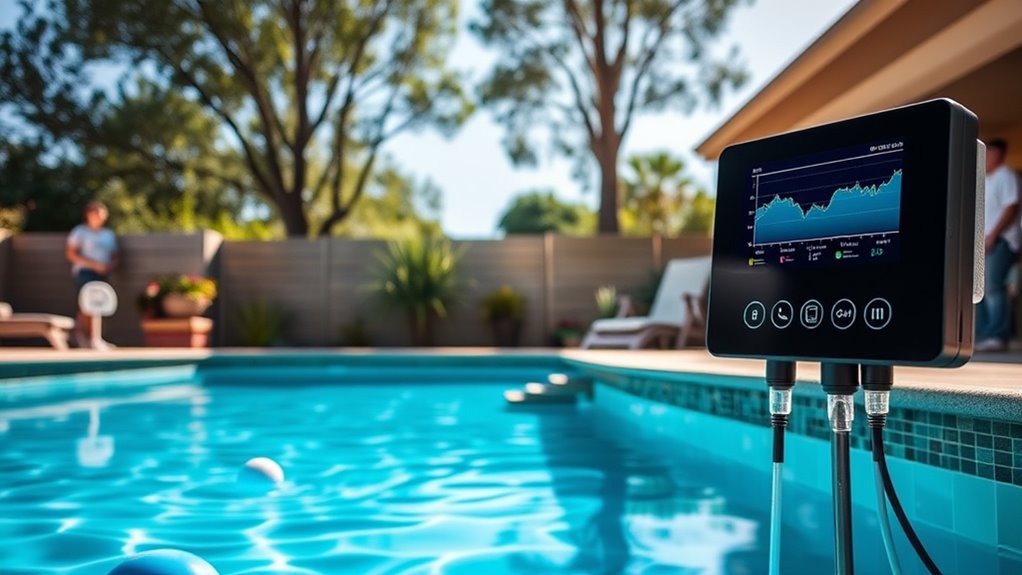
With automated chemical balance management, you can guarantee your water stays ideal without constant manual adjustments. Precise chemical dosing, real-time water testing, and automatic pH adjustments work together to keep your system balanced. This technology simplifies maintaining water quality and saves you time and effort. Additionally, vetted products ensure safety and effectiveness in your pool management system.
Precise Chemical Dosing
Automated chemical balance management guarantees that chemical levels are maintained accurately and consistently, minimizing human error. Precise chemical dosing ensures your pool stays balanced without guesswork. When your system detects fluctuations in pH, alkalinity, or sanitizer levels, it automatically adjusts the dosing. This real-time responsiveness prevents issues like algae growth, cloudy water, or skin irritation. You don’t need to manually add chemicals or worry about over or under-dosing. Instead, your smart system calculates the exact amount needed and dispenses it efficiently. This not only keeps your water crystal clear but also extends the life of your equipment by maintaining ideal chemical levels. With precise dosing, you enjoy a hassle-free swimming experience, knowing your pool’s chemistry is always in perfect balance. Total-cost clarity helps you understand the ongoing expenses associated with maintaining optimal chemical levels over time.
Real-Time Water Testing
Real-time water testing revolutionizes pool maintenance by providing instant, accurate data on water chemistry. With smart systems, you no longer need to manually test and guess your chemical levels. Instead, sensors continuously monitor pH, chlorine, alkalinity, and other essential parameters, sending real-time updates to your control system. This constant feedback allows for immediate adjustments, ensuring your water remains balanced and safe. You’ll notice clearer water, fewer chemical errors, and less guesswork. Automated water testing also detects issues early, preventing problems before they escalate. By integrating this technology, you spend less time on maintenance and more time enjoying your pool. It’s a smarter, more efficient way to keep your water pristine without constantly checking test strips or manual tests. Additionally, understanding the state tax implications for IRA withdrawals can help retirees optimize their income and savings strategies.
Automated Ph Adjustment
Maintaining proper pH levels is essential for safe and comfortable swimming, and automated pH adjustment systems make this task effortless. These systems continuously monitor your pool’s pH and automatically add the right amount of acid or base to keep levels balanced. You won’t need to test manually or guess when to adjust chemicals, as the system handles everything in real-time. This automation ensures ideal water quality, prevents corrosion or scaling, and keeps your pool comfortable for swimmers. Plus, it reduces chemical waste and saves you time. With automated pH adjustment, you can enjoy a consistently balanced pool without constant maintenance, giving you peace of mind and more time to relax and swim. Understanding chemical balance is crucial to maintaining a healthy swimming environment.
Temperature Control and Climate Optimization
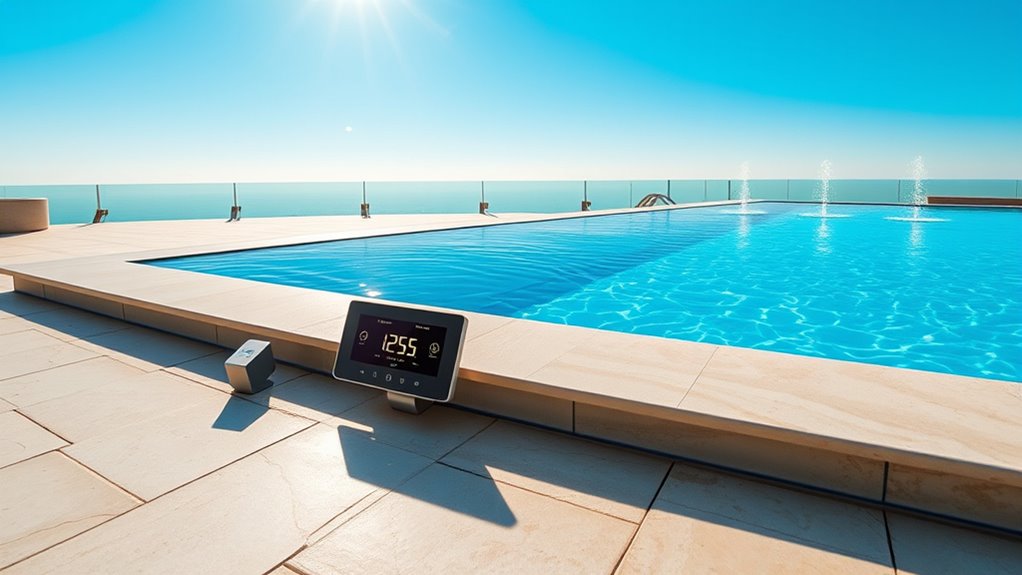
You can easily set precise temperatures to keep your environment just right. Climate adjustment features automatically fine-tune conditions based on your preferences or external changes. This ensures peak comfort and efficiency without constant manual intervention. Additionally, noise levels of the system are designed to be minimal, preventing disturbance while maintaining optimal climate control.
Precise Temperature Settings
Achieving ideal comfort and efficiency hinges on setting precise temperatures within automated systems. With smart pool systems, you can program your desired water temperature accurately, ensuring consistent warmth whenever you swim. These systems monitor temperature levels continuously, making real-time adjustments to maintain your preferred setting. No more guesswork or manual tweaks—your pool stays at the perfect heat without unnecessary energy waste. You can easily set different temperatures for various times of the day or week, optimizing your pool usage. This precision not only enhances your swimming experience but also saves energy and reduces costs. By controlling temperatures accurately, you create a more comfortable environment while maximizing efficiency, all with minimal effort on your part. Temperature regulation features are essential for maintaining optimal conditions and conserving energy.
Climate Adjustment Features
Climate adjustment features in automated systems dynamically optimize indoor and outdoor environments by regulating temperature and humidity levels. They adjust settings based on your preferences, weather forecasts, and time of day, ensuring comfort without manual effort. Imagine a system that detects rising outdoor heat and cools your pool area automatically, or increases humidity during dry seasons to keep the air comfortable. Here’s a visual to help picture it:
| Condition | Response |
|---|---|
| Hot, Sunny Day | Cool the pool area, activate shade, reduce humidity |
| Cold, Windy Night | Increase heating, add humidity, close vents |
| Humid, Rainy Weather | Dehumidify, close windows, regulate airflow |
| Dry, Sunny Day | Add moisture, optimize ventilation |
| Mild, Overcast | Maintain current settings, monitor conditions |
This seamless adjustment keeps your environment perfect, effortlessly. Additionally, hybrid bicycles exemplify adaptable technology by combining multiple features to suit diverse terrains and uses, much like climate control systems optimize comfort across varying conditions.
Robotic Cleaning and Maintenance Features

Robotic cleaning and maintenance features have become essential components of modern automation systems, enabling devices to operate efficiently with minimal human intervention. These robots are designed to handle tasks like vacuuming the pool floor, walls, and waterline, ensuring your pool stays clean and inviting. Equipped with sensors and programmable routes, they automatically detect dirt, debris, and algae, adjusting their cleaning patterns as needed. Maintenance features such as automatic filter cleaning or alert systems notify you when service is required, reducing downtime and prolonging equipment lifespan. With these smart tools, you don’t need to manually scrub or monitor every detail. Instead, your pool stays pristine with little effort on your part, giving you more time to enjoy your backyard oasis.
Remote Monitoring and Control via Apps
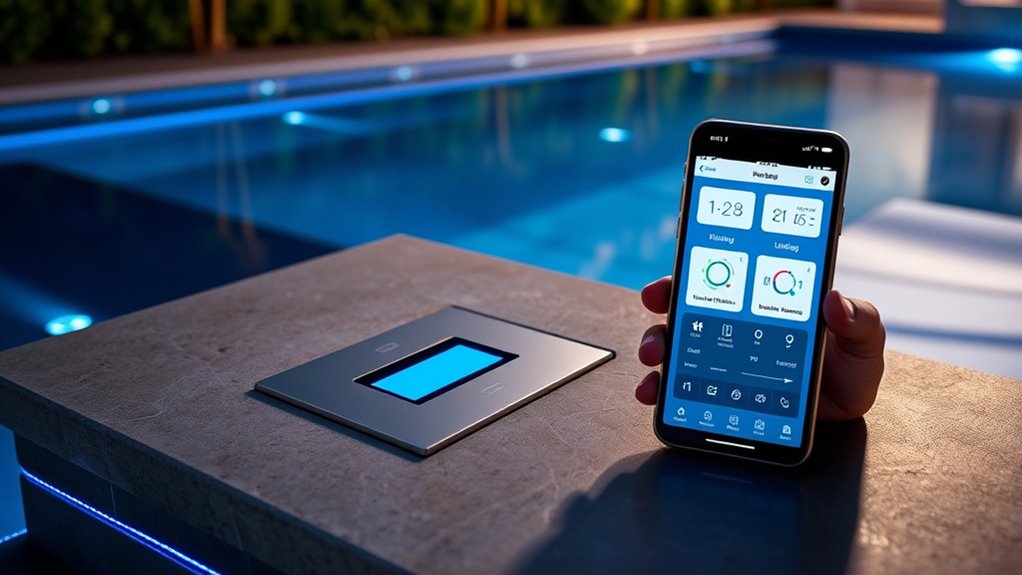
With the rise of smart technology, you can now monitor and control your automation systems remotely through dedicated apps. This feature puts pool management at your fingertips, offering convenience and immediate control. Here’s what you can do:
- Adjust water temperature and pump speeds instantly, no matter where you are.
- Receive real-time alerts for system malfunctions or maintenance needs.
- Schedule filtration cycles and lighting to match your pool usage.
- View current system status and historical data for better maintenance planning.
- Many apps also integrate wiring basics and safety features to ensure your system operates reliably and securely.
These apps sync seamlessly with your pool’s automation hardware, giving you full command from your smartphone or tablet. This level of control simplifies pool care and guarantees your pool is always ready for use.
Energy Efficiency and Cost Savings
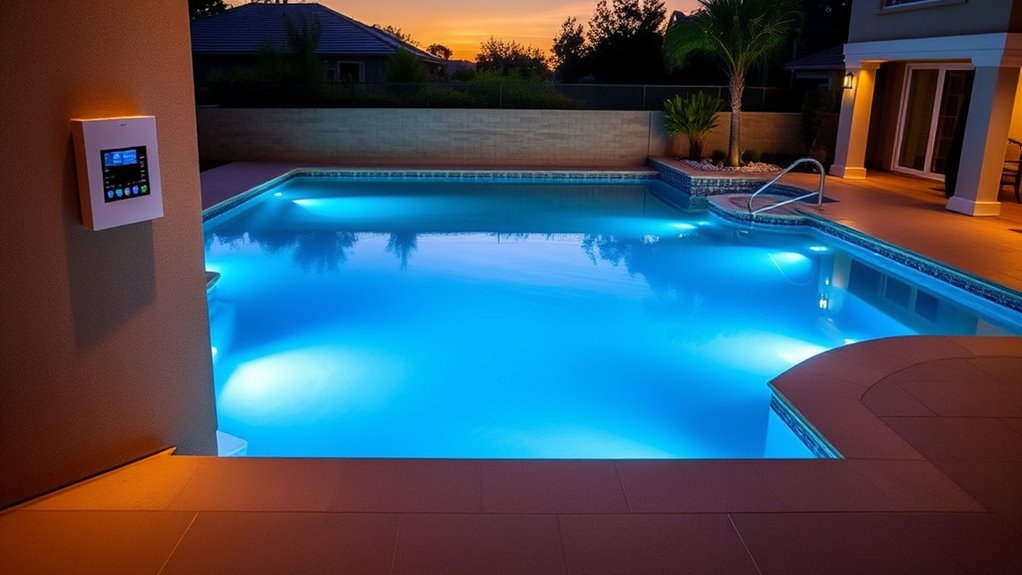
By optimizing your pool’s automation system, you can substantially reduce energy consumption and lower ongoing costs. Smart controls allow you to schedule pumps, heaters, and lights to run only when needed, preventing waste. For example, setting the heater to operate during off-peak hours saves energy and money. Here’s how automation boosts efficiency:
| Feature | Benefit |
|---|---|
| Programmable Timers | Avoid unnecessary operation, saving power |
| Remote Adjustments | Fine-tune settings without manual intervention |
| Sensor Integration | Optimize based on water temperature and usage |
Additionally, integrating energy-efficient components into your automation setup enhances overall savings and performance.
Integrating Smart Pool Systems With Home Automation

Integrating smart pool systems with home automation enhances convenience and efficiency by allowing you to control your pool seamlessly alongside other smart devices. This integration simplifies managing your entire home environment from a single platform. You can:
- Automate pool cleaning schedules based on weather or usage patterns.
- Sync pool lighting with outdoor security or indoor ambiance settings.
- Use voice commands to adjust water temperature or activate features.
- Receive real-time alerts about pump performance or chemical levels.
Frequently Asked Questions
How Secure Are Remote Access Features for Smart Pool Systems?
Remote access features for smart pool systems can be quite secure if you take proper precautions. Many systems use encryption and secure login protocols to protect your data. However, you should always update your software regularly, use strong, unique passwords, and enable two-factor authentication if available. By staying vigilant and following best security practices, you can enjoy the convenience of remote access while keeping your pool system safe from potential cyber threats.
Can Smart Pool Systems Detect and Alert for Equipment Failures?
Did you know that 65% of pool owners experience equipment failures annually? Smart pool systems can indeed detect and alert you about equipment issues. They monitor parameters like pump performance, filter pressure, and chemical levels, sending real-time notifications to your device. This proactive approach helps prevent costly repairs and water damage, giving you peace of mind. With these alerts, you’re always informed and can act quickly to maintain ideal pool health.
What’s the Typical Installation Process for Integrating a Smart Pool System?
You start by turning off your pool’s power supply. Next, mount the smart system’s hub and sensors in designated spots, usually near your equipment and water. Connect the system to your Wi-Fi, then follow the app’s setup instructions to pair devices. Once installed, configure your preferences, run a test, and verify everything communicates properly. It’s straightforward and usually takes a couple of hours, depending on your setup.
Are Smart Pool Features Compatible With Existing Pool Equipment Brands?
Smart pool features are like puzzle pieces fitting together, and compatibility depends on your existing equipment. Many systems work seamlessly with popular brands, but some may require adapters or upgrades. Check the system’s compatibility list or consult your installer before purchasing. If you have older equipment, you might need to replace certain components to guarantee smooth integration. Doing this upfront saves you time and ensures your pool automation functions flawlessly.
How Often Should Software Updates Be Performed on Smart Pool Systems?
You should perform software updates on your smart pool system whenever they’re available, ideally every few months or as recommended by the manufacturer. Regular updates guarantee your system runs smoothly, stays secure, and benefits from new features. Check your app or system notifications frequently, and don’t delay installing updates, as they often fix bugs and improve performance, helping you enjoy a trouble-free, automated swimming experience.
Conclusion
Imagine your pool as a well-orchestrated symphony, where each smart system plays its part seamlessly. With the right setup, you’ll spend less time fussing and more time enjoying. Just like a smart thermostat that learns your schedule, these systems adapt to your needs, making maintenance feel effortless. Once you experience the convenience, you’ll wonder how you ever managed without automation—turning pool care from a chore into a smooth, effortless dance.
